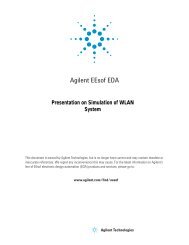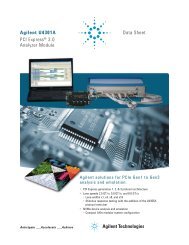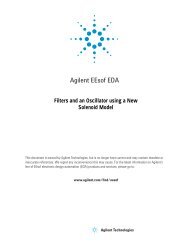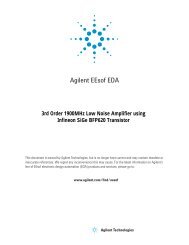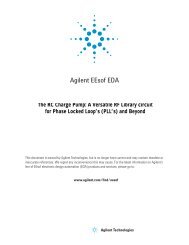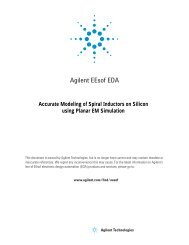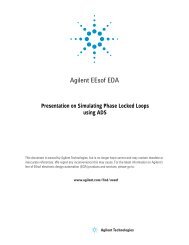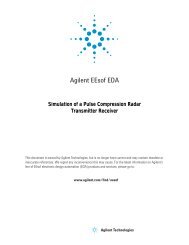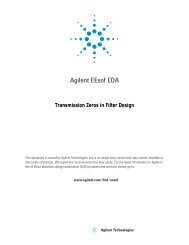Interference Testing with Handheld Spectrum Analyzers - Agilent ...
Interference Testing with Handheld Spectrum Analyzers - Agilent ...
Interference Testing with Handheld Spectrum Analyzers - Agilent ...
Create successful ePaper yourself
Turn your PDF publications into a flip-book with our unique Google optimized e-Paper software.
<strong>Interference</strong><br />
<strong>Testing</strong> <strong>with</strong><br />
<strong>Handheld</strong> <strong>Spectrum</strong><br />
<strong>Analyzers</strong><br />
Application Note
Table of Contents<br />
Introduction ........................................................................................................................ 3<br />
Wireless Systems and <strong>Interference</strong> .................................................................... 4<br />
Radio Duplexing .............................................................................................................. 6<br />
Half-duplex ........................................................................................................................... 6<br />
Full-duplex ............................................................................................................................ 6<br />
Example: Duplexing’s role in interference identification ............................................. 7<br />
Sources of <strong>Interference</strong> .............................................................................................. 9<br />
Example: Locating interference source ......................................................................... 9<br />
<strong>Interference</strong> categories .................................................................................................... 12<br />
Receivers and <strong>Spectrum</strong> <strong>Analyzers</strong> ................................................................... 13<br />
Receiver anatomy ............................................................................................................. 13<br />
<strong>Spectrum</strong> analyzer functionality ..................................................................................... 14<br />
Power levels ...................................................................................................................... 15<br />
Example: Properly setting power levels ....................................................................... 16<br />
<strong>Interference</strong> Measurement Procedure ............................................................ 19<br />
Capturing intermittent signals ........................................................................................ 20<br />
Estimating the interferer’s location ............................................................................... 22<br />
<strong>Interference</strong> Classifications and Measurement Examples ................. 23<br />
In-band interference ......................................................................................................... 23<br />
Co-channel interference .................................................................................................. 23<br />
Out-of-band interference ................................................................................................. 24<br />
Adjacent channel interference ....................................................................................... 26<br />
Downlink interference ...................................................................................................... 28<br />
Uplink interference ...........................................................................................................28<br />
Conclusion ........................................................................................................................ 28<br />
2
Introduction<br />
Wireless communications systems co-exist across the RF and microwave<br />
frequency spectrum and are designed to operate <strong>with</strong> a limited amount of interference.<br />
As wireless systems often share or reuse frequency spectrum, interference<br />
from other users can quickly become an issue. When the amplitude of an<br />
interfering signal becomes relatively large as compared to the signal of interest<br />
then the interference can reduce system performance in a variety of ways.<br />
Commercial and government agencies working in industries such as cellular,<br />
broadcast radio and television, radar, and satellite are often required to continually<br />
monitor the frequency spectrum for interference from known and unknown<br />
signals, to ensure proper system performance and regulatory compliance.<br />
For example, interference issues commonly occur when a transmitter is improperly<br />
radiating energy into the same or adjacent frequency channels. In some<br />
cases, the wireless signal may be interference to sensitive equipment such as<br />
the case when cellular transmissions in close proximity to electroencephalogram<br />
(EEG) monitors may obstruct the operation of the equipment. Since all<br />
wireless systems are subject to the effects of interference, it is important to be<br />
able to quickly and accurately measure the frequency spectrum in and around<br />
the wireless system.<br />
This application note introduces the processes and techniques for measuring<br />
and locating wireless interference using a portable handheld spectrum analyzer<br />
(HSA). As interference testing may include carrier-specific measurements, wide<br />
bandwidth spectrum searching, data logging, and finding the location of the<br />
offending transmitter, the HSA requires several important characteristics. The<br />
test instrument needs to provide:<br />
• a broad range of frequency coverage<br />
• fast measurement sweeps<br />
• high dynamic range<br />
• data storage<br />
• ruggedness<br />
• portability<br />
While there is a variety of test equipment available for accurately measuring<br />
the amplitude and frequency content of wireless signals, the <strong>Agilent</strong> N934xC<br />
Series and N9340B handheld spectrum analyzers (HSAs) are ideally suited when<br />
speed, accuracy, and portability are essential for field operations.<br />
3
Wireless Systems and <strong>Interference</strong><br />
Wireless communications, traditionally known as radio communications, use<br />
radio waves operating <strong>with</strong> carrier frequencies in the range of 3 kHz to 300 GHz.<br />
While it appears that this radio spectrum is very wide, practical considerations,<br />
such as performance, power, and equipment cost typically limit most carrier<br />
frequencies from less than 6 GHz up to 20 GHz. Operators, including the majority<br />
of commercial, military, and public safety wireless systems, operate at carrier<br />
frequencies less than 6 GHz. Meanwhile, satellite and radar systems operate<br />
<strong>with</strong> carriers as high as 20 GHz and above.<br />
As frequency spectrum is a limited resource, local government agencies<br />
regulate its use by assigning frequency ranges or “bands” to different types<br />
of systems in order to balance the interests of commercial, public safety, and<br />
military organizations.<br />
For example, wireless local area network (WLAN) communications used in<br />
laptops and numerous handheld devices may operate <strong>with</strong> carrier frequencies<br />
over the 2.4 to 2.4835 GHz band or the 5.15 to 5.825 GHz band. Each of these<br />
frequency bands is typically sub-divided into frequency channels that are shared<br />
among all the users in the system. The channel spacing of WLAN systems<br />
varies between 5 and 20 MHz respectively. In contrast, a broadcast AM radio<br />
band operating over the frequency band from 520 to 1,710 kHz is subdivided into<br />
individual channels spaced by 9 or 10 kHz depending on the region.<br />
The channel spacing is spread far enough apart so that adjacent channels on<br />
either side of the desired channel are filtered out by the receiver’s channel filter.<br />
Interfering signals that are close to the desired channel may pass through the<br />
channel filter and corrupt the receiver’s operation.<br />
If a wireless system is experiencing performance issues, a spectrum analyzer<br />
can be used to examine the radio spectrum around the desired channel to verify<br />
whether the reduced performance is the result of interference <strong>with</strong>in the operating<br />
channel or the adjacent channels.<br />
Figure 1 shows the spectrum of a wireless signal for a WLAN system that was<br />
showing a lower than expected performance. For this measurement, the <strong>Agilent</strong><br />
N9342C HSA was connected to an external antenna and positioned near the<br />
WLAN transceiver. Initially the spectrum appeared to be free of interference,<br />
though occasionally a small amplitude change was seen offset approximately<br />
1 MHz from the center frequency. Once the system transmitter was switched<br />
off, it was discovered that a narrowband signal was transmitting in the same<br />
channel.<br />
4
Wireless Systems and <strong>Interference</strong> (continued)<br />
Main signal<br />
Potential interference<br />
Figure 1. Measured spectrum of a<br />
discovered in-band interference when the<br />
main transmitter was switched on<br />
Figure 2 shows the spectrum of this “in-band” interference <strong>with</strong> the WLAN<br />
transmitter switched off. Now that a potential cause was discovered for the<br />
performance problems, the next steps would be to find the location of the inband<br />
interference and work to lower or eliminate the interference effect on the<br />
system.<br />
In-band interference<br />
Figure 2. Measured spectrum of a<br />
discovered in-band interference when the<br />
main transmitter was switched off<br />
5
Radio Duplexing<br />
Knowing that the radio spectrum has a limited number of channels and the<br />
number of users continues to grow, many radios system are designed to share a<br />
single frequency channel by dividing the transmission time among several users.<br />
This is called duplexing. For example, a cellular GSM mobile subscriber (MS) will<br />
transmit signals to the base transceiver station (BTS) using an assigned time<br />
slot along <strong>with</strong> the assigned frequency channel. The North American (NA) GSM<br />
850 system divides a 4.615 millisecond length of time into 8 time slots for sharing<br />
the frequency channel between multiple users in order to increase system<br />
capacity. This technique is referred to as time division multiple access (TDMA).<br />
In regards to interference, an in-band interferer could now affect multiple users<br />
that are time sharing this TDMA frequency channel.<br />
Half-duplex<br />
Wireless communication radios typically contain a transmitter and a receiver<br />
but in some systems, only one is active at a time. These types of radios are<br />
referred to as “half-duplex” and allow for simple, low-cost radio configurations.<br />
An example of a half duplex configuration is a push-to-talk (PTT) radio used<br />
by emergency service personnel and available as an option on many cellular<br />
networks. Data communication devices such as WLAN also use a half-duplex<br />
configuration. If the half-duplex radio uses the same frequency channel for both<br />
its transmitter and receiver, then an interfering signal would corrupt both links<br />
of the communication system.<br />
Full-duplex<br />
Wireless systems that allow the simultaneous transmission and reception<br />
of signals, such as found in traditional cellular and military intelligence,<br />
surveillance, and reconnaissance (ISR) point-to-point radios, are referred to as<br />
“full-duplex” radios. These full-duplex radios typically use separate frequency<br />
channels for the transmitter and the receiver. Using the example of a cellular<br />
system, communication from the mobile transmitter to the BTS, referred as the<br />
uplink or forward link, operates at a different frequency channel than the communication<br />
from the BTS to the mobile receiver, referred to as the downlink or<br />
return link. The reason to separate the uplink and downlink signals is to prevent<br />
the mobile’s own transmit signal from leaking into the mobile’s receiver and<br />
appearing as an interference that could not be filtered if the two operated on the<br />
same channel.<br />
A specialized filter, called the duplexing filter, can separate two frequency<br />
channels and, when placed between the mobile’s transmitter, the receiver<br />
and antenna, allows two communications links to occur at the same time. A<br />
full-duplex radio system is effectively just two separate communication links<br />
occurring in independent frequency channels, transmitting at the same time. In<br />
regards to in-band or co-channel interference, the frequency separation between<br />
the two communication links would result in an interfering signal affecting only<br />
one side of the communication, either as an uplink or a downlink interference.<br />
This information is useful when troubleshooting performance issues in a<br />
wireless network. For example, the NA GSM 850 has uplink channels in the<br />
frequency band covering 824.2 to 848.8 MHz, and downlink channels from 869.2<br />
to 893.8 MHz. If the system is experiencing problems only on the downlink, the<br />
first place to look for interference is over the range of downlink frequencies.<br />
6
Radio Duplexing (continued)<br />
Example: Duplexing’s role in interference identification<br />
Figure 3 shows an over-the-air measurement across a portion of the NA GSM<br />
850 downlink frequency band. The measurement was taken from the <strong>Agilent</strong><br />
HSA <strong>with</strong> an omni-directional antenna, commonly called a “rubber ducky” type<br />
antenna, attached to the analyzer. The figure displays several of the concepts<br />
just mentioned, including subdividing the frequency band into multiple channels<br />
and time sharing the spectrum and downlink transmission. Figure 3 shows two<br />
active GSM channels centered at 870.0 and 870.4 MHz. The difference between<br />
the two channels is that the left channel, centered at 870.0 MHz, is transmitting<br />
<strong>with</strong> data only in a few time slots, while the channel centered at 870.4 MHz,<br />
on the right, is transmitting continually <strong>with</strong> data in all time slots, resulting in a<br />
smoother distribution of measured power.<br />
Transmitter on<br />
Transmitter off<br />
Sweep direction<br />
15.9 ms<br />
Figure 3. Over-the-air measurement of a<br />
GSM 850 downlink transmission using an<br />
<strong>Agilent</strong> HSA <strong>with</strong> attached antenna<br />
870.0 MHz<br />
(channel 134)<br />
870.4 MHz<br />
(channel 136)<br />
Sweep time<br />
7
Radio Duplexing (continued)<br />
The reason for the breaks in the measured response for the left channel,<br />
centered at 870.0 MHz, is that this radio is not transmitting all the time and the<br />
spectrum analyzer is measuring the rapid changes in the signal amplitude as the<br />
analyzer sweeps across the display. As the analyzer was configured <strong>with</strong> a total<br />
sweep time of 159.32 milliseconds, each horizontal box is approximately<br />
15.9 milliseconds long. It was previously mentioned that a NA GSM 850 signal<br />
has a 4.615 millisecond frame time containing 8 time slots; therefore each box<br />
on the analyzer display contains approximately 3.5 frames of user data. As some<br />
time slots do not always contain user data, the transmitter is switched off during<br />
these empty slots resulting in an uneven spectrum response as the analyzer<br />
sweeps.<br />
Later in this application note, there is a discussion on techniques to confirm that<br />
the signal has time slots rather than just a series of closely spaced narrowband<br />
signals which may have been the first impression when examining the display<br />
shown in Figure 3.<br />
8
Sources of <strong>Interference</strong><br />
<strong>Interference</strong> becomes a problem when a wireless system no longer operates as<br />
expected. Even though regulatory agencies and standards organizations define<br />
wireless operation and protocols <strong>with</strong>in each frequency band, interference from<br />
intentional and unintentional radiators may have detrimental effects on system<br />
performance.<br />
<strong>Interference</strong> from unintentional radiators include:<br />
• electrical equipment<br />
• switching power supplies<br />
• clocks<br />
• control signals<br />
• ignition motors<br />
• other mechanical machinery<br />
• microwave ovens<br />
• other home appliances<br />
• photocopiers<br />
• printers<br />
• fluorescent and plasma lighting<br />
• power lines<br />
Unintentional radiators can produce either broadband noise or potentially modulate<br />
the radio signals propagating in the surrounding environment. Environment<br />
conditions such as lightning and precipitation static can degrade system performance<br />
and potentially damage electronic components.<br />
<strong>Interference</strong> from intentional radiators include radio transmissions from other<br />
wireless systems such as:<br />
• broadcast radio and television<br />
• cellular<br />
• satellite<br />
• radar<br />
• mobile radio<br />
• cordless phones<br />
It should be noted that the majority of radio interference is generated from<br />
other wireless systems operating <strong>with</strong> faulty transmitters and repeaters or from<br />
systems that are maliciously attempting to disrupt communications possibly in a<br />
military combat situation.<br />
9
Sources of <strong>Interference</strong> (continued)<br />
Example: Determining the source of interference<br />
As a simple experiment to show the impact of unintentional interference, consider<br />
the effect of fluorescent lighting on radio transmission. An RF signal generator<br />
was configured to transmit an un-modulated carrier. A spectrum analyzer<br />
was used to compare the measured frequency spectrum under two conditions:<br />
first <strong>with</strong> the lighting switched off, and then <strong>with</strong> the lights switched on.<br />
The signal generator, an <strong>Agilent</strong> N5182A MXG vector signal generator, was<br />
configured to output an un-modulated 915 MHz signal <strong>with</strong> -10 dBm amplitude.<br />
An omni-directional (rubber ducky-type) antenna was attached directly to the<br />
signal generator. The spectrum analyzer, an <strong>Agilent</strong> N9342C HSA, was configured<br />
to measure the spectrum around a center frequency of 915 MHz. A second<br />
antenna was attached directly to the <strong>Agilent</strong> HSA and initially the fluorescent<br />
lighting was switched off.<br />
Under these conditions, the N9342C HSA has a convenient backlit keypad for<br />
instrument control and the instrument screen self-adjusts to a variety of lighting<br />
conditions from total darkness to full sunlight (see Figure 4). Figure 5 shows<br />
the measurement display from the <strong>Agilent</strong> N9342C spectrum analyzer when the<br />
office lights were turned off.<br />
Figure 4. Backlit keypad and instrument<br />
screen make it easy to work in any<br />
environment<br />
10
Sources of <strong>Interference</strong> (continued)<br />
Reference level<br />
Marker<br />
10 dB<br />
Figure 5. Over-the-air measurement<br />
of a 915 MHz RF signal in an office<br />
environment <strong>with</strong> the lighting turned off<br />
Hint:<br />
It is important to properly adjust<br />
the reference level so that the<br />
signal does not appear to be<br />
clipped off the top of the graph.<br />
Center frequency<br />
Frequency span<br />
The analyzer center frequency was set to “915MHz” using the [FREQ] button<br />
and the displayed frequency span was set to “500kHz” using the [SPAN] button.<br />
The top line of the graph is the reference level and is adjustable using the<br />
[AMPTD] button. The reference level is adjusted to optimize the measurement<br />
display; in this case, the reference level was set to “-40dBm”. Using the default<br />
scaling, each vertical box represents an amplitude difference of 10 dB, shown<br />
as “10dB/” on the screen. Therefore <strong>with</strong> a total of 10 boxes, the bottom line on<br />
the graph represents “-140dBm”.<br />
The measured trace in Figure 5 shows a single RF carrier <strong>with</strong>out modulation.<br />
The maximum amplitude level and frequency of the signal was measured using<br />
a marker placed at the peak of the signal. The marker functions, including “peak<br />
search”, are found on the <strong>Agilent</strong> HSAs but similar functions are available on<br />
most commercially-available spectrum analyzers. Using the marker, the peak<br />
amplitude is measured to be -49.84 dBm at the expected frequency of 915 MHz.<br />
For this measurement, <strong>with</strong>out the fluorescent lights, the spectrum appears<br />
relatively clean of any spurious or sideband modulation.<br />
Next, the lights were switched on and the spectrum was measured for a second<br />
time. Figure 6 shows the measured spectrum <strong>with</strong> the fluorescent lighting and<br />
now the spectrum includes undesired sidebands modulated onto the RF carrier.<br />
This interference has been introduced into the RF signal by the electronic ballast<br />
of the fluorescent light fixtures.<br />
11
Sources of <strong>Interference</strong> (continued)<br />
Delta marker<br />
<strong>Interference</strong><br />
Figure 6. Over-the-air measurement<br />
of a 915 MHz RF signal in an office<br />
environment <strong>with</strong> the fluorescent lighting<br />
turned on. Shown are the modulation<br />
sidebands of the 43 kHz operating<br />
frequency of the electronic lighting ballast<br />
Another marker function was used to measure the difference between the peak<br />
signal level and the largest interference sideband. The “delta marker” function,<br />
also found under the [MARKER] menu, reports a -34.11 dB difference between<br />
the peak signal and the largest interference just right of the signal peak. The frequency<br />
difference is 43 kHz, which is the operating frequency of the fluorescent<br />
lighting ballast. The other interference sidebands are the harmonics of this<br />
43 kHz frequency.<br />
For many wireless systems, these relatively low levels of interference as compared<br />
to the signal amplitude would not greatly affect the system performance<br />
but to some systems, such as a RFID system using passive UHF RFID tags, this<br />
level of interference could have a negative effect on system performance.<br />
12
Receivers and <strong>Spectrum</strong> <strong>Analyzers</strong><br />
<strong>Interference</strong> affects a radio system when it enters the receiver and corrupts<br />
the detector in the receiver. If the amplitude of the interference is very large,<br />
the interference can overpower the receiver’s front-end electronics and reduce<br />
system performance. Filters are added to the receiver to eliminate interference<br />
and noise from entering the system, but any interference that falls <strong>with</strong>in the<br />
passband of these filters are combined <strong>with</strong> the desired signal.<br />
Receiver anatomy<br />
Figure 7 shows a simple block diagram of the four main functions of a receiver:<br />
amplification, down-conversion, filtering, and detection.<br />
BPF<br />
Amp<br />
Downconversion<br />
Channel<br />
filter<br />
Detector<br />
Figure 7. Block diagram of a receiver<br />
system. Dotted line represents the<br />
components in a typical spectrum<br />
analyzer<br />
In<br />
Out<br />
The bandpass filter (BPF) at the input is set wide enough to allow the entire<br />
block of frequency channels to pass while rejecting interference outside the<br />
operating frequency range. Amplification in a receiver is required for two<br />
reasons: first is that power entering the receiver antenna can be as low as -100<br />
to -120 dBm and amplification is necessary to increase the signal power above<br />
the required sensitivity of the detector. Second, the receiver electronics will<br />
add noise to the signal as the signal moves along the receive path. By adding a<br />
low-noise amplifier near the input, the receiver’s signal-to-noise ratio (SNR) can<br />
be improved. Amplification is typically spread along the entire receive path but is<br />
shown in Figure 7 as a single component for simplicity in the diagram.<br />
The down-converter block function is to tune the system to a specific frequency<br />
channel and then translate the high frequency radio signal to a lower frequency<br />
in order to ease the process of detection. The lower frequency output from the<br />
down-converter is selected to match the center frequency of the channel filter.<br />
The channel filter improves the selectivity of the system by attempting to reject<br />
signals in the adjacent channels and beyond. The detector, often referred to as<br />
the demodulator, recovers the transmitted data that may include voice, video, or<br />
other forms of data.<br />
13
Receivers and <strong>Spectrum</strong> <strong>Analyzers</strong> (continued)<br />
<strong>Spectrum</strong> analyzer functionality<br />
The block diagram for a spectrum analyzer is similar to the receiver shown in<br />
Figure 7 except that a typical spectrum analyzer does not include the front-end<br />
BPF. By removing the BPF, the spectrum analyzer is not limited to a specific<br />
band of measurement frequencies and can be configured to continually tune<br />
across a broad range of frequencies.<br />
Hint:<br />
Care should be taken to guarantee<br />
that all signals are safely below<br />
the rated damage level before<br />
connecting those signals to the HSA.<br />
Figure 7 shows a dotted line box around the functions contained in a broadband<br />
spectrum analyzer, such as the <strong>Agilent</strong> N934xC Series or N9340B HSAs which<br />
are capable of measuring radio frequencies from 9 kHz to 20 GHz. The detector<br />
in a spectrum analyzer converts the energy that passes through the channel<br />
filter to a signal that can be displayed on the instrument as the analyzer scans<br />
across the frequency range of interest.<br />
A few important points to note about a spectrum analyzer are that the equivalent<br />
channel filter in the spectrum analyzer is called the resolution bandwidth<br />
filter (RBW) and the bandwidth of the RBW can be easily adjusted from the<br />
instrument keypad. Also, as the front-end BPF is not included at the input to<br />
the analyzer, any signal having large amplitude that enters the instrument could<br />
overload or damage the instrument. Therefore, even if the instrument is tuned<br />
to measure a narrow range of frequencies, large amplitude signals operating at<br />
other frequencies will also enter the instrument and can potentially damage the<br />
electronics.<br />
This caution is especially important when measuring the spectrum of nearby<br />
transmitters that often have power levels exceeding the input power rating of<br />
the instrument. Care should be taken to guarantee that all signals are safely<br />
below the rated damage level before connecting those signals to the instrument.<br />
14
Receivers and <strong>Spectrum</strong> <strong>Analyzers</strong> (continued)<br />
Power levels<br />
For example, the high power damage level on the <strong>Agilent</strong> N9342C HSA is<br />
+33 dBm, or 2 watts, for 3 minutes. Measuring signals <strong>with</strong> power levels above<br />
+33 dBm would require the use of an external attenuator or coupler placed at<br />
the input to the spectrum analyzer. Also note that the HSA Series analyzers<br />
require less than ±50 volts DC from entering the input, which is typically not<br />
a problem when the HSA is connected to an antenna, but could be an issue<br />
when connecting to a system that may include DC power along <strong>with</strong> the radio<br />
transmission.<br />
One change to the block diagram shown in Figure 7 that would be typical for<br />
a general purpose spectrum analyzer is the addition of a variable attenuator<br />
placed before the down-converter. The variable attenuator can be adjusted to<br />
optimize the power level entering the down-converter. This may appear counterintuitive<br />
as a function of the receiver is to amplify input signals, but since the<br />
spectrum analyzer is also used to measure high-power transmitters, the frontend<br />
gain is generally not required. The analyzer’s attenuator can be manually<br />
increased or set to “automatic” to avoid an overload condition. These functions<br />
are found under the [AMPTD] menu of the N934xC and N9340B HSAs.<br />
When measuring very low amplitude level signals and interference the variable<br />
attenuator should be set to 0 dB to maximize the signal level into the downconverter.<br />
In some analyzers, such as the <strong>Agilent</strong> N934xC and N9340B, the<br />
front-end amplifier, or pre-amp, is an option that can be switched in or out to<br />
further increase the sensitivity of the instrument. The pre-amp can be manually<br />
adjusted or automatically selected when choosing the HiSensitivity feature on<br />
the [AMPTD] menu of the N934xC and N9340B HSAs.<br />
15
Receivers and <strong>Spectrum</strong> <strong>Analyzers</strong> (continued)<br />
Example: Properly setting power levels<br />
To provide an example of the proper setting for the power levels entering a<br />
spectrum analyzer, Figure 8 shows the measured spectrum of two wideband<br />
signals. The main signal centered at 2.42 GHz and the adjacent channel interference<br />
is centered at 2.444 GHz. In order for both waveforms to be observed on<br />
the same display, the <strong>Agilent</strong> HSA center frequency was set to the midpoint of<br />
2.432 GHz using the [FREQ] button and the frequency span was set to 60 MHz<br />
using the [SPAN].<br />
<strong>Interference</strong><br />
Main signal<br />
30 dB<br />
2.42 GHz<br />
2.444 GHz<br />
Figure 8. Measurement of two wideband<br />
signals <strong>with</strong> an adjacent channel<br />
interference having 30 dB more power<br />
than the desired signal. Note that both<br />
signals are easily observed using a<br />
frequency span of 60 MHz<br />
Span<br />
60 MHz<br />
Knowing that the vertical scaling is set to 10 dB per box it is easy to see that<br />
the amplitude of the interference is approximately 30 dB larger than the main<br />
signal. As the interfering signal is the larger of two signals entering the input to<br />
the analyzer, it would be the power of interference that may overdrive the frontend<br />
of the spectrum analyzer.<br />
Figure 9 shows the spectrum of only the main signal using a narrower span of<br />
20 MHz and a center frequency of 2.42 GHz. Even though the interference is<br />
not displayed <strong>with</strong> a 20 MHz span, the interference is still being applied to the<br />
input of the analyzer and could overload the front-end of the analyzer. In some<br />
applications it may be necessary to place a filter on the input to the spectrum<br />
analyzer in order to remove any large amplitude signals that are not part of the<br />
measurement but may overload the analyzer’s down-converter. It is always the<br />
largest signal at the input to the analyzer that sets the top end of the “dynamic<br />
range” for the instrument even if the signal is not shown on the instrument<br />
display.<br />
16
Receivers and <strong>Spectrum</strong> <strong>Analyzers</strong> (continued)<br />
<strong>Interference</strong><br />
Main signal<br />
2.42 GHz<br />
Figure 9. Measurement of a single<br />
wideband signal. The adjacent channel<br />
interference is still present at the input of<br />
the spectrum analyze but not shown on<br />
the display due to the narrow frequency<br />
span of 20 MHz<br />
Span<br />
20 MHz<br />
The bottom end of the dynamic range is set by the spectrum analyzer noise<br />
floor. A signal will not be observed if the signal’s amplitude is below the<br />
noise floor of the spectrum analyzer. The noise floor is determined by several<br />
factors including the amount of pre-amp gain/attenuation and the RBW filter<br />
setting. The pre-amp and attenuator controls can be automatically set using<br />
the “HiSensitivity” feature available on the <strong>Agilent</strong> N934xC and N9340B HSAs.<br />
HiSensitivity mode sets the input attenuator to 0 dB, turns on the HSA’s internal<br />
preamplifier and sets the reference level to -50 dBm. The mode is found under<br />
the [AMPTD].<br />
Figure 10 shows an overlay of two measurements <strong>with</strong> and <strong>with</strong>out the<br />
HiSensitivity control. The noise floor of the analyzer is improved by approximately<br />
20 dB when the pre-amp is included in the measurement and the input<br />
attenuator is set to 0 dB.<br />
17
Receivers and <strong>Spectrum</strong> <strong>Analyzers</strong> (continued)<br />
Hi<br />
Sensitivity<br />
OFF<br />
20 dB<br />
Figure 10. Measurement showing the<br />
noise floor improvement when using<br />
the HiSensitivity setting on the <strong>Agilent</strong><br />
H934xC Series HSA<br />
Hi<br />
Sensitivity<br />
ON<br />
Even <strong>with</strong>out a pre-amp, the noise floor of the analyzer can be optimized using<br />
the RBW filter. The RBW filter on the <strong>Agilent</strong> N934xC HSA is adjusted under the<br />
[BW] menu and using the {RBW} setting. Often an automatic setting for RBW<br />
will provide a sufficient noise floor on the instrument and manually reducing the<br />
RBW will further reduce the observable noise floor.<br />
Figure 11 shows the improvement in the measured noise floor when the RBW<br />
is reduced by a factor of ten. For this measurement, the RBW was manually<br />
changed from 100 kHz to 10 kHz and the noise floor improved by 10 dB. In this<br />
example, the measured peak was the same in both cases, as would be the case<br />
for any signal that has bandwidth smaller than the RBW setting. As a result, the<br />
measured SNR is improved due to a change in the noise floor.<br />
Peak<br />
RBW =<br />
100 kHz<br />
Figure 11. Improvement in the analyzer’s<br />
noise floor when reducing the RBW<br />
setting by a factor of 10. For narrow<br />
bandwidth signals, the SNR improves<br />
when the RBW is reduced<br />
10 dB<br />
RBW =<br />
10 kHz<br />
18
Receivers and <strong>Spectrum</strong> <strong>Analyzers</strong> (continued)<br />
Figure 12 shows a similar measurement but <strong>with</strong> a signal having a much wider<br />
bandwidth. Once again, the noise floor dropped by 10 dB as the RBW was<br />
changed from 100 kHz to 10 kHz, but as the signal’s bandwidth is now wider<br />
than the RBW, and therefore appears as noise to the RBW filter, the peak amplitude<br />
of the signal also dropped by 10 dB. As a result, the measured SNR does<br />
not improve when measuring wide bandwidth signals.<br />
10 dB<br />
RBW =<br />
100 kHz<br />
Figure 12. Improvement in the analyzer’s<br />
noise floor when reducing the RBW<br />
setting by a factor of 10. For wide<br />
bandwidth signals, the SNR does not<br />
improve when the RBW is reduced<br />
10 dB<br />
RBW =<br />
10 kHz<br />
19
<strong>Interference</strong> Measurement Procedure<br />
<strong>Interference</strong><br />
measurement procedure<br />
Below is a list of steps that<br />
can be used to determine the<br />
existence and location of an<br />
interfering signal.<br />
1. Report that a reduction in<br />
the system performance is<br />
observed<br />
2. Confirm the existence of<br />
wireless interference using<br />
a spectrum analyzer<br />
3. Determine the type of interference<br />
by knowing about<br />
other wireless signals in<br />
the environment<br />
4. Determine the location of<br />
the interference using a<br />
spectrum analyzer <strong>with</strong> a<br />
directional antenna<br />
5. Correct or remove the<br />
source of interference<br />
Once it has been reported that the system is not operating as expected and it is<br />
assumed that the root cause of the problem is interference entering the receiver<br />
of the system, a spectrum analyzer should be used to confirm the existence of<br />
wireless signals in the frequency channel of operation.<br />
The discovery process may involve uncovering the type of signal including duration<br />
of transmission, number of occurrences, carrier frequency and bandwidth,<br />
and lastly the physical location of the interfering transmitter.<br />
If the system operates in full-duplex mode, then it may be necessary to examine<br />
both the forward and reverse link frequency channels for signs of interference.<br />
For the spectrum analyzer to measure the same signals and interference that<br />
the system receiver is capturing, the spectrum analyzer should be connected<br />
into the receive path or directly to the system antenna.<br />
Figure 13A shows a block diagram of a wireless system <strong>with</strong> the spectrum<br />
analyzer connected to a directional coupler placed between the antenna and the<br />
transceiver. Many wireless systems, including cellular base stations and radar<br />
stations, will have directional couplers installed along the cables connecting the<br />
transceiver to the system antenna. As shown in Figure 13A, some directional<br />
couplers will have two sample points for monitoring the signals coming from the<br />
transmitter or arriving to the receiver. After the spectrum analyzer is connected<br />
to the coupler, the signals and interference can be observed during normal<br />
system operation.<br />
(A)<br />
Radio<br />
transceiver<br />
Transmit<br />
monitor<br />
Directional coupler<br />
Receive<br />
monitor<br />
System<br />
antenna<br />
N9342C HSA<br />
(B)<br />
System or<br />
external<br />
antenna<br />
Figure 13. <strong>Spectrum</strong> analyzer<br />
configurations for measuring wireless<br />
interference <strong>with</strong> (A) using a directional<br />
coupler and (B) direct connection to the<br />
antenna<br />
N9342C HSA<br />
20
<strong>Interference</strong> Measurement Procedure (continued)<br />
For radios that do not provide access between the transceiver and the antenna,<br />
the spectrum analyzer can be directly connected to the system antenna or<br />
connected to an external antenna <strong>with</strong> the analyzer placed in the area near<br />
the transceiver as shown in Figure 13B. During the discovery process, an<br />
omni-directional antenna is a good choice so that signals from all directions are<br />
measured from the surrounding environment. Omni-directional type antennas<br />
include the rubber-ducky and whip antennas.<br />
If possible, turning off the system transmitter allows the spectrum analyzer<br />
to measure in-band and co-channel interference <strong>with</strong> the lowest noise floor<br />
settings as previously discussed. In this case, it is assumed that any nearby<br />
out-of-band and adjacent channel transmitters have signal levels low enough so<br />
that the spectrum analyzer front-end is not overloaded.<br />
Capturing intermittent signals<br />
Intermittent signals are often the most difficult to measure. The radio performance<br />
occasionally suffers from interference at what may seemingly be random<br />
times of the day. For cases when the interference is pulsed or intermittent, the<br />
spectrum analyzer can be configured to store the maximum trace values over<br />
many sweeps. Recalling the over-the-air measurement in Figure 3, the lower<br />
channel of the GSM 850 signal was only transmitting during a few time slots<br />
resulting in a measured waveform that displayed breaks in the envelope.<br />
Placing the spectrum analyzer in “maximum hold” mode, the instrument will<br />
fill in the gaps after several sweeps. The {Max Hold} selection is found under<br />
the [TRACE] menu on the <strong>Agilent</strong> HSAs and the results for the GSM 850 signal<br />
using the maximum hold is shown in Figure 14. It is now apparent from<br />
Figure 14 that the signals in the two channels have a similar spectrum and<br />
power distribution.<br />
Max. hold<br />
Figure 14. Over-the-air measurement of<br />
a GSM 850 downlink transmission using<br />
the <strong>Agilent</strong> N934xC HSA <strong>with</strong> the trace<br />
“Maximum Hold” selected<br />
870.0 MHz<br />
(channel 134)<br />
870.4 MHz<br />
(channel 136)<br />
21
<strong>Interference</strong> Measurement Procedure (continued)<br />
The trace option on the <strong>Agilent</strong> HSAs allows up to four different traces to be<br />
displayed. The multiple traces can include combinations of Max Hold, Min Hold,<br />
stored memory, and active measurements <strong>with</strong> different detection options<br />
including the default “positive peak”. Additional information regarding detection<br />
modes can be found in the <strong>Agilent</strong> application note "8 Hints for Better <strong>Spectrum</strong><br />
Analysis" (literature number 5965-7009E).<br />
Another useful display option on the <strong>Agilent</strong> HSA is the spectrogram. A spectrogram<br />
is a unique way to examine frequency, time, and amplitude on the same<br />
display. The spectrogram shows the progression of the frequency spectrum as a<br />
function of time where a color scale represents the amplitude of the signal. In a<br />
spectrogram, each frequency trace occupies a single, horizontal line (one pixel<br />
high) on the display. Elapsed time is shown on the vertical axis resulting in a<br />
display that scrolls upwards as time progresses.<br />
Figure 15 shows a spectrogram of a signal <strong>with</strong> a transmitter that is intermittently<br />
active. In the figure, the red color in the spectrogram represents the frequency<br />
content <strong>with</strong> the highest signal amplitude. The spectrogram may provide<br />
an indication to the timing of the interference and how the signal bandwidth<br />
may change over time. The spectrogram can be stored to the internal memory of<br />
the <strong>Agilent</strong> HSA or onto an external USB flash drive.<br />
Spectogram<br />
Transmitter On<br />
Transmitter Off<br />
Time<br />
Transmitter On<br />
Figure 15. Dual display option showing a<br />
spectrogram and the frequency spectrum<br />
of a signal <strong>with</strong> intermittent transmission<br />
Color scale<br />
22
<strong>Interference</strong> Measurement Procedure (continued)<br />
The spectrogram can record 1,500 sets of spectrum data in a single trace file<br />
<strong>with</strong> an update interval that is set by the user. The HSA will automatically create<br />
another trace file to save continuously beyond 1,500 sets. For example, on the<br />
N9344C HSA sweeping across the full 20 GHz frequency span, the sweep time<br />
would be 0.95 seconds. In this case, in one single trace file, the user can set the<br />
spectrogram to store data over 48 minutes using an update interval of 1 second<br />
or up to 5 days using an update interval of 300 seconds. The spectrogram display<br />
is activated using the {SPECTROGRAM} selection under the [MEAS] menu.<br />
Estimating the interferer’s location<br />
Once the interference is observed using the spectrum analyzer, understanding<br />
the type of signal, such as WIFI, cellular, or other may be helpful in estimating<br />
the interferer’s location. For example, a wireless equipment operator maintaining<br />
a cellular network may observe an “out of spec” transmission from an adjacent<br />
frequency channel. Knowing that the type of interference is from another<br />
cellular system may provide clues that a nearby repeater may be improperly<br />
transmitting energy into the adjacent bands.<br />
Hint:<br />
To make locating the interference<br />
source easier, connect a high gain<br />
directional antenna, such as a yagi<br />
or patch antenna, to the HSA.<br />
The last step in the discovery process is locating the source of the interference.<br />
At this point, it is preferred that a directional antenna be connected to the spectrum<br />
analyzer since these high gain antennas provide pointing capability <strong>with</strong>in<br />
the wireless environment. Directional antenna types include yagi and patch<br />
antennas. Antenna gain of 5 dBi or higher is recommended for this application.<br />
For example, <strong>Agilent</strong>’s N9311X-508 directional antenna provides a 5 dBi gain<br />
over the frequency range of 700 MHz to 8 GHz.<br />
Observing the amplitude of the signal on the spectrum analyzer as the<br />
directional antenna is moved around the environment could potentially point<br />
to the physical location of the interference when the signal amplitude is at a<br />
maximum. Unfortunately multipath reflections in the surrounding environment<br />
could reduce the pointing accuracy so it is important to make the measurement<br />
from as high as possible such as on rooftops or tall buildings. Cellular base station<br />
(BTS) antennas are usually configured <strong>with</strong> sectorized antennas having a<br />
narrow beamwidth and, using a measurement configuration as shown in Figure<br />
13A, may provide an approximate direction (sector) for the interference.<br />
By combining directional measurements from several locations around an<br />
environment, it may be possible to triangulate an approximate position for the<br />
interfering transmitter. The exact location of the source usually requires driving<br />
or walking around a smaller area <strong>with</strong> the portable spectrum analyzer and<br />
directional antenna looking for the maximum signal amplitude. Once the source<br />
of the interference is located, the final step is to correct or remove the offending<br />
transmitter.<br />
23
<strong>Interference</strong> Classifications and Measurement<br />
Examples<br />
<strong>Interference</strong><br />
classifications<br />
• In-band interference<br />
• Co-channel interference<br />
• Out-of-band interference<br />
• Adjacent channel interference<br />
• Uplink interference<br />
• Downlink interference<br />
<strong>Interference</strong> to radio signals can come from a number of sources including interference<br />
created by one’s own radio system or by interference created from other<br />
radio systems and unintentional radiators such as nearby electrical equipment<br />
and mechanical machinery. It was previously mentioned that radio interference<br />
can fall into a number of categories and these are explained in this section of<br />
the application note along <strong>with</strong> a few measurement examples.<br />
In-band interference<br />
In-band interference is an undesired transmission from a different communication<br />
system or unintentional radiator that falls inside the operating bandwidth<br />
of the desired system. This type of interference passes through the receiver’s<br />
channel filter and if the interference amplitude is large relative to the desired<br />
signal, the desired signal will be corrupted.<br />
As previously shown in Figure 1, a different radio system was transmitting<br />
directly in the operating channel of the desired system. This figure shows a<br />
potential interference located at a center frequency slightly higher than the<br />
desired. Figure 6 showed another form of in-band interference created from an<br />
unintentional radiator, in this case, the desired RF signal is being modulated by<br />
fluorescent lighting. In the cases when the interferer is intentionally attempting<br />
to disrupt communications, this in-band interferer would be considered a radio<br />
“jammer”.<br />
The easiest way to observe in-band radio interference is to turn off the transmitter<br />
of the desired radio and use the spectrum analyzer tuned to the channel<br />
frequency to look for other signals operating in the channel of interest. For<br />
unintentional radiators potentially modulating the desired signal, turn off the<br />
offending radiator, such as the lighting in Figure 6. It may be necessary to set<br />
the spectrum analyzer to HiSensitivity mode and use the Max Hold display or a<br />
spectrogram to record any intermittent signals. HiSensitivity mode sets the input<br />
attenuator to 0 dB, turns on the HSA’s internal preamplifier and sets the reference<br />
level to -50 dBm. The mode is found under [AMPTD], {More (1 of 2)}.<br />
Co-channel interference<br />
This type of interference creates similar conditions as in-band interference<br />
except that co-channel interference comes from another radio operating in the<br />
same wireless system. In this case, two or more signals are competing for the<br />
same frequency spectrum.<br />
For example, cellular base stations will re-use the same frequency channel<br />
when the base stations are physically located far apart, but occasionally the<br />
energy from one base station will reach a neighboring cell area and potentially<br />
disrupt communications. WLAN networks also experience co-channel interference.<br />
This is because the WLAN radios listen for an open channel before<br />
transmitting and the potential exists for two radios to transmit simultaneously<br />
and collide in the same frequency channel.<br />
24
<strong>Interference</strong> Classifications and Measurement<br />
Examples (continued)<br />
Co-channel interference is one of the most common types of radio interference<br />
as system designers attempt to support a large number of wireless users <strong>with</strong>in<br />
a small number of available frequency channels.<br />
The easiest way to observe co-channel interference is to turn off the transmitter<br />
of the desired radio and use the spectrum analyzer tuned to the channel<br />
frequency to look for other signals from the desired system. It may be necessary<br />
to set the spectrum analyzer to HiSensitivity mode and use the Max Hold display<br />
or a spectrogram to record any intermittent signals.<br />
Out-of-band interference<br />
Out-of-band interference originates from a wireless system designed to transmit<br />
in a different frequency band while also producing energy in the frequency band<br />
of the desired system. Such is the case when a poorly designed or malfunctioning<br />
transmitter creates harmonics that fall into a higher frequency band.<br />
Harmonics are multiples (2x, 3x, 4x, etc) of the fundamental carrier transmission.<br />
For example, Figure 16 shows the spectrum of a transmitter designed to operate<br />
at 500 MHz. The measurement, taken from the <strong>Agilent</strong> HSA, shows the fundamental<br />
component at 500 MHz and a second harmonic transmitting at<br />
1,000 MHz. This second harmonic signal could potentially interfere <strong>with</strong> other<br />
wireless systems operating near 1,000 MHz.<br />
Main signal<br />
2nd harmonic<br />
500 MHz<br />
1000 MHz<br />
Figure 16. Measurement of 500 MHz<br />
unfiltered transmitter showing second<br />
harmonic generated at the output<br />
25
<strong>Interference</strong> Classifications and Measurement<br />
Examples (continued)<br />
It is important, and often a regulatory requirement, to properly filter out the<br />
harmonics of a transmitter so that one wireless system does not affect another<br />
system operating in a higher frequency band. When examining harmonics of a<br />
wireless transmitter, it is necessary to use a spectrum analyzer <strong>with</strong> a frequency<br />
range of at least three times the fundamental operating frequency of the system.<br />
For example, when verifying the performance of a transmitter operating at<br />
6 GHz, it may be necessary to measure second and third harmonics at 12 GHz<br />
and 18 GHz respectively. In this case, the <strong>Agilent</strong> N934xC Series includes models<br />
<strong>with</strong> frequency ranges up to 7, 13.6 and 20 GHz.<br />
Hint:<br />
When examining harmonics, use a<br />
spectrum analyzer <strong>with</strong> a frequency<br />
range of at least three times the<br />
fundamental operating frequency.<br />
Not all out-of-band interference is harmonically related to the fundamental carrier;<br />
spurious signals fall into this category. Spurious signals are typically generated<br />
in a transmitter resulting from improper shielding of the switching power<br />
supplies and clocking signals, or from poorly designed frequency oscillators.<br />
Spurious signal interference that fall into the passband of the desired system<br />
may have an undesired effect on system performance.<br />
Out-of-band interference may also occur when two or more wireless services<br />
operate in the same geographic area and experience a phenomenon called<br />
“near-far”. A common form of this interference occurs in a cellular environment<br />
when a mobile radio is far from the desired BTS, and very near to a BTS of a<br />
competing service provider. Even though both systems operate in different<br />
frequency bands, the mobile receives an energy level from the nearest BTS that<br />
is much higher than the desired BTS station. The front-end bandpass filter in the<br />
mobile will reject most of the energy from the close BTS but some energy will<br />
leak through the filter and into the pre-amp/down-converter, potentially corrupting<br />
the desired signal due to non-linearities in the receiver’s electronics.<br />
The easiest way to observe out-of-band interference is to turn off the transmitter<br />
of the desired radio and first verify the amplitude levels of any signals across<br />
a wide frequency range. Next, if all the signals are low relative to the desired<br />
signal, tune the spectrum analyzer to the channel frequency and look for other<br />
signals <strong>with</strong>in the channel. It may be necessary to set the spectrum analyzer to<br />
HiSensitivity mode and use the Max Hold display or a spectrogram to record any<br />
intermittent signals.<br />
26
<strong>Interference</strong> Classifications and Measurement<br />
Examples (continued)<br />
Adjacent channel interference<br />
This interference is the result of a transmission at the desired frequency<br />
channel producing unwanted energy in other channels. Adjacent channel<br />
interference is common and primarily created by energy splatter out of the<br />
assigned frequency channel and into the surrounding upper and lower channels.<br />
This energy splatter, often referred to as intermodulation distortion or spectral<br />
re-growth, is created in the high-power amplifiers of the radio transmitter due to<br />
nonlinear effects in the power electronics.<br />
The details of intermodulation distortion are not included in this application note<br />
and additional information can be found in the <strong>Agilent</strong> product note "Optimizing<br />
Dynamic Range for Distortion Measurements" (literature number 5980-3079EN).<br />
As an example of intermodulation distortion, Figure 17 shows a measurement of<br />
a digitally modulated signal transmitting on Channel 2. In the figure, Channels<br />
1 (lower) and 3 (upper) represent the adjacent channels relative to this main<br />
transmission.<br />
Channel 1 Channel 2 (main) Channel 3<br />
PASS<br />
Limit<br />
lines<br />
Figure 17. Measurement of adjacent<br />
channel power and limit testing<br />
Channel<br />
power<br />
& ACPR<br />
27
<strong>Interference</strong> Classifications and Measurement<br />
Examples (continued)<br />
The <strong>Agilent</strong> HSA was configured to automatically measure the power in the<br />
main channel and adjacent channels using the adjacent channel power ratio<br />
{ACPR} measurement found under the [MEAS] menu. The table under the spectrum<br />
display lists the total power, in dBm, for the main channel and the adjacent<br />
upper and lower channels. The {ACPR} measurement also reports the power<br />
ratio, in dB, between the main channel and each of the two adjacent channels.<br />
Limit lines can be placed on the display of the <strong>Agilent</strong> HSA as a quick check of<br />
compliance to the radio specifications. Limit lines are defined under the [LIMIT]<br />
menu. Figure 17 shows that the measured spectrum for this transmitter has<br />
“passed” the power and frequency requirements across the three channels.<br />
Figure 18 shows a similar measurement but this transmitter has an increase in<br />
the adjacent channel power and exceeded the limit line specifications resulting<br />
in the “fail” notation to be displayed on the instrument screen. As adjacent<br />
channel power measurements are typically made on the transmitter output, it is<br />
not necessary to use the HiSensitivity mode on the <strong>Agilent</strong> HSA. It is important<br />
that the transmitter signal level is reduced to a point that the HSA is not overloaded.<br />
Limit test<br />
FAIL<br />
Figure 18. Measurement of adjacent<br />
channel power and limit testing showing<br />
a out of limit condition<br />
28
<strong>Interference</strong> Classifications and Measurement<br />
Examples (continued)<br />
Downlink interference<br />
This type of interference corrupts the downlink or forward link communications<br />
typically between a BTS and a mobile device. Because of the relatively widelyspaced<br />
distribution of mobile devices, downlink interference only impacts a<br />
minority of mobile users and has a minimal impact on the communication quality<br />
of the system as a whole.<br />
Uplink interference<br />
Also called reverse link interference, uplink interference affects the BTS’s<br />
receiver and the associated communications from the mobiles to the BTS. Once<br />
the BTS is compromised, the cell site’s entire service area may experience<br />
degraded performance.<br />
Conclusion<br />
This application note has described the techniques and procedures for interference<br />
testing in a wireless environment. The classifications for different types of<br />
interference including in-band, co-channel, out-of-band, and adjacent channel<br />
interference were discussed. <strong>Spectrum</strong> measurements were made on a variety<br />
of wireless signals to show the effectiveness that portable spectrum analyzers,<br />
such as the <strong>Agilent</strong> N934xC and N9340B handheld spectrum analyzers, can have<br />
when identifying and locating the source of radio interference.<br />
29
For More Information<br />
Visit any of the following handheld<br />
spectrum analyzer product pages<br />
and click on the "Document Library"<br />
tab to access additional application<br />
notes:<br />
• www.agilent.com/find/n9344c<br />
• www.agilent.com/find/n9343c<br />
• www.agilent.com/find/n9342c<br />
• www.agilent.com/find/n9340b<br />
<strong>Agilent</strong> Email Updates<br />
www.agilent.com/find/emailupdates<br />
Get the latest information on the<br />
products and applications you select.<br />
<strong>Agilent</strong> Channel Partners<br />
www.agilent.com/find/channelpartners<br />
Get the best of both worlds: <strong>Agilent</strong>’s<br />
measurement expertise and product<br />
breadth, combined <strong>with</strong> channel<br />
partner convenience.<br />
<strong>Agilent</strong> Advantage Services is committed<br />
to your success throughout your equipment’s<br />
lifetime. To keep you competitive,<br />
we continually invest in tools and<br />
processes that speed up calibration and<br />
repair and reduce your cost of ownership.<br />
You can also use Infoline Web Services<br />
to manage equipment and services more<br />
effectively. By sharing our measurement<br />
and service expertise, we help you create<br />
the products that change our world.<br />
www.agilent.com/find/advantageservices<br />
www.agilent.com/quality<br />
www.agilent.com<br />
www.agilent.com/find/hsa<br />
www.agilent.com/find/hsa-videos<br />
For more information on <strong>Agilent</strong><br />
Technologies’ products, applications or<br />
services, please contact your local <strong>Agilent</strong><br />
office. The complete list is available at:<br />
www.agilent.com/find/contactus<br />
Americas<br />
Canada (877) 894 4414<br />
Brazil (11) 4197 3500<br />
Mexico 01800 5064 800<br />
United States (800) 829 4444<br />
Asia Pacific<br />
Australia 1 800 629 485<br />
China 800 810 0189<br />
Hong Kong 800 938 693<br />
India 1 800 112 929<br />
Japan 0120 (421) 345<br />
Korea 080 769 0800<br />
Malaysia 1 800 888 848<br />
Singapore 1 800 375 8100<br />
Taiwan 0800 047 866<br />
Other AP Countries (65) 375 8100<br />
Europe & Middle East<br />
Belgium 32 (0) 2 404 93 40<br />
Denmark 45 70 13 15 15<br />
Finland 358 (0) 10 855 2100<br />
France 0825 010 700*<br />
*0.125 €/minute<br />
Germany 49 (0) 7031 464 6333<br />
Ireland 1890 924 204<br />
Israel 972-3-9288-504/544<br />
Italy 39 02 92 60 8484<br />
Netherlands 31 (0) 20 547 2111<br />
Spain 34 (91) 631 3300<br />
Sweden 0200-88 22 55<br />
United Kingdom 44 (0) 131 452 0200<br />
For other unlisted countries:<br />
www.agilent.com/find/contactus<br />
Revised: June 8, 2011<br />
Product specifications and descriptions<br />
in this document subject to change<br />
<strong>with</strong>out notice.<br />
© <strong>Agilent</strong> Technologies, Inc. 2011<br />
Published in USA, October 11, 2011<br />
5990-9074EN





